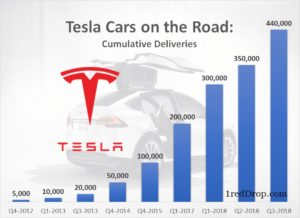Tesla, Inc.
Tesla, Inc. is a U.S headquartered Multinational Corporation that makes fully electric vehicles, energy generation and storage systems, and also sells solar electricity.
Founded in 2003, by Martin Eberhard and Marc Tarpenning, the company was named after electrical engineer and physicist Nikola Tesla.
Tesla become the first American automaker to go public since Ford in 1956. The July 2010 IPO was a success as the company raised $226.1 million and shares surged 41% in their first day of trade.
According to Tesla they are the world’s only vertically integrated sustainable energy company, offering end-to-end clean energy products, including generation, storage and consumption.
Current Models
Tesla currently produces three fully electric vehicles, the Model S sedan, the Model X sport utility vehicle (“SUV”) and the Model 3 sedan.
Upcoming Models
The Tesla Semi, an all-electric Class 8 semi-trailer truck, was unveiled at a press conference on November 16, 2017. Production is slated to begin in 2019.
Tesla unveiled the 2020 Roadster, at the end of the event that introduced the Semi.
In February 2018, Tesla announced that they would unveil Model Y production plans within the next 3-6 months. Tesla announced in August 2017 that Model Y will be built using the Model 3 platform.
Discontinued Models
As of December 31, 2012, Tesla had delivered approximately 2,450 Tesla Roadsters to customers in over 30 countries
Manufacturing Facilities
Tesla manufactures vehicles primarily at facilities in
-
Fremont, California
-
Lathrop, California
-
Tilburg, Netherlands
-
Gigafactory 1 near Reno, Nevada.
-
Gigafactory 3, Lingang, Pudong, Shanghai, China
Solar products at factories in
-
Fremont, California
-
Buffalo, New York (Gigafactory 2)
Manufactures energy storage products at
-
Gigafactory 1
In its fourth quarter 2016 investor letter, Tesla said that the company is planning to finalize locations for Gigafactories 3, 4 and possibly 5. The first Gigafactory Tesla has been working on is a $5 billion investment.
“In the future, all Gigafactories will include vehicle production. So, right now, vehicle production and battery production, like battery production and motor and power electronics and charger production are at Giga, and then, we have our Fremont car factory. But future Gigafactories will all incorporate vehicle production.” said Elon Musk during first quarter 2018 earnings call
Tesla’s worldwide sales crossed 100,000 units in Q4-2015 , 200,000 in Q1-2017 300,000 in Q1-2018 and 440,000 in Q3-2018
As of September 2018, Model S remains the top seller for Tesla with global sales of 249,990 units between June 2012 and June 2018, followed by Model X with 106,689 units since September 2015, and Model 3 with 84,230 units between July 2017 and September 2018.
The discontinued Tesla Roadster sales stand at 2,450 units.
The United States remains the largest market for Tesla, followed by China and Norway. These three markets accounted for 72.8% of Tesla’s sales in 2017.
United States: Tesla remains the top EV seller in United States. Tesla Model 3 is the top-selling EV in the United States with 114,532 deliveries between January and November 2018, followed by Toyota Prius Prime at 24,836 units, Tesla Model S at 22,495 units, Tesla Model X at 22,000 units and Chevrolet Volt at 18,648 units. Tesla crossed the 200,000 units sales in the United States in July 2018 , which triggered the phase-out of US Federal Tax Credit.
Federal Tax Credit US:
Once an EV manufacturer sells 200,000 units in the United States, vehicles sold during the quarter that happens as well as the following quarter get the full tax rebate of $7,500. The credit is reduced to $3,750 for the next 6 months, then to $1,875 for the next 6 months and then it expires completely.(L) (Energy.gov)
China: In 2017, Tesla doubled its sales in China to over $2.027 billion, after tripling sales in 2016 compared to the year before. In the first three quarters of 2018, Tesla reported revenue of $1.445 billion, compared to $1.531 billion last year.
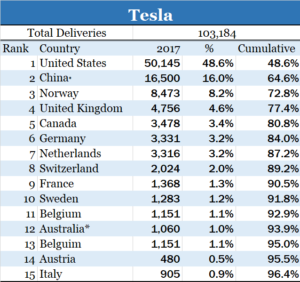
Australia: According to Australian Financial Review, Tesla Motors Australia tripled its revenue to $160.7 million in 2017, compared to $52.6 million in 2016. (L) Tesla held nearly 50% of Australia’s EV marketshare in 2017.
Germany: Tesla continued to struggle in Germany as the company sold just 3,331 units in 2017, where total new car registrations for the year touched 3.44 million units. (L)
Tesla Guidance: Tesla expects to deliver 100,000 Model S and Model X in 2018. Tesla targets peak production of 5000 Model 3s per week in June 2018 and 6000 in July 2018.
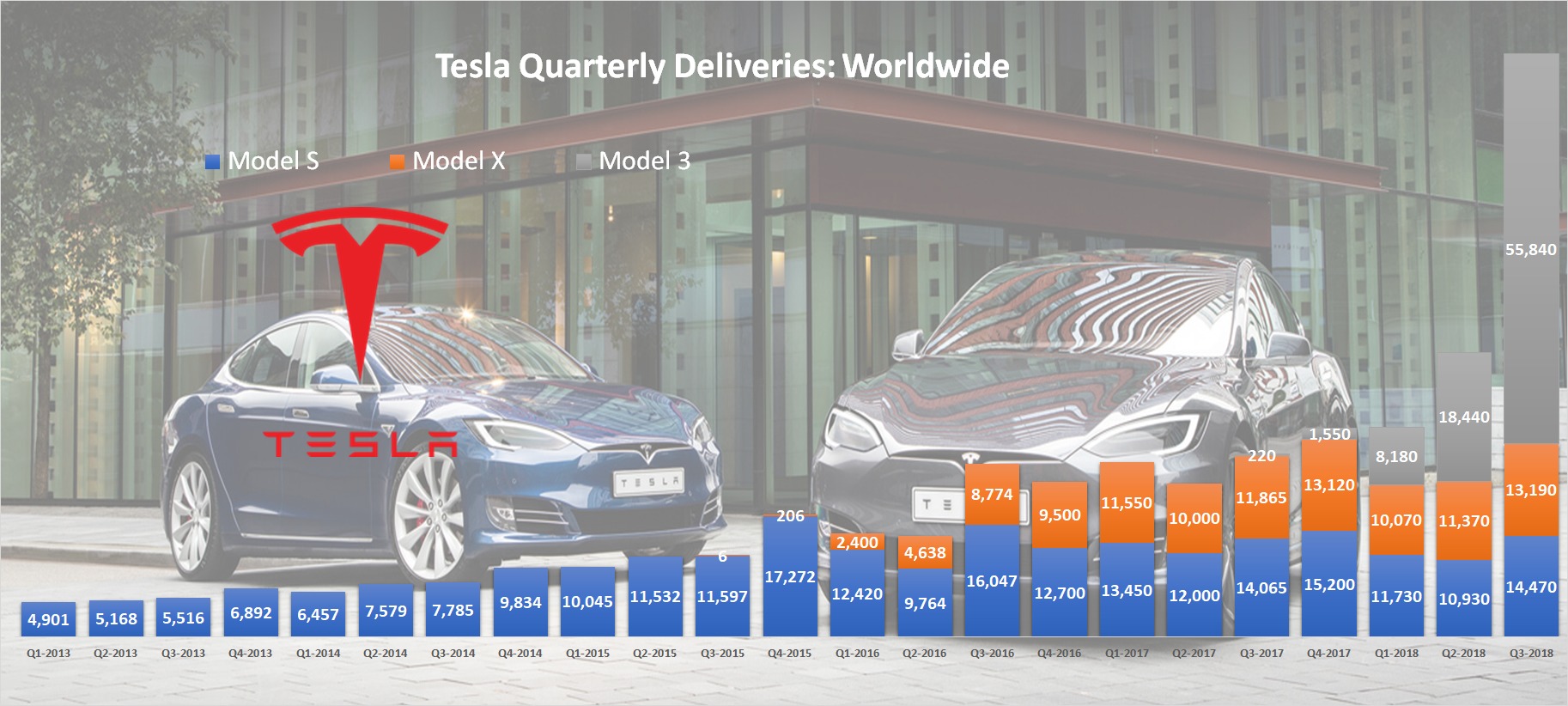
First Half of 2018: January to June
United States: In the first six months of 2018, Tesla reportedly sold 44,612 Model S/3/X vehicles compared to 20,140 units the company sold last year during the same period.
China: Though third party sales figures won’t be available till the end of this year, according to Bloomberg data, Tesla recorded $508.7 million in revenue during the first quarter of 2018 compared to $503.0 million in the first quarter of 2017.
Europe: In Norway, Tesla’s number one market in Europe, the company sold 4,046 Model S and Model X in the first six months of the current fiscal compared to 2,362 units the company sold during the same period last year.
Sales in Europe during the first half of 2018 (including Norway) is 13,599 units compared to 12,230 units last year.
Canada: Tesla sold 732 Model S, 854 Model X and 2,306 Model 3. Total sales now reads 3,892 units in the first six months of 2018, which is already more than the 3,478 units Tesla sold in Canada last year. (12 months)
Resale Value Guarantee: Tesla launched its “Resale Value Guarantee Program” in April 2013, ten months after Model S went on sale in September 2012. The electric car maker had just $202 million in cash by the end of 2012 and they reported a net loss of $396 million for the fiscal.
Elon Musk said he will personally back a plan to reassure Tesla buyers. “Even if Tesla is unable to honor it, I will personally do so. That’s what I mean by putting my money where my mouth is,” said Musk in a conference call with reporters. (L)
The guarantee allowed Tesla customers to trade in the Model S after three years for the same residual value % of Mercedes-Benz S class. “If a Mercedes S-class is worth 43% of its original value after three years and a Model S owner wants to sell his car after three years, he would be guaranteed to get at least 43% of the Tesla’s original purchase price.” – CNN
A month after launching the plan Tesla announced that it is raising the Model S resale value guarantee to be the highest of any premium sedan brand made in volume.(L)
After selling 129,398 Model S sedans between June 2012 and June 2016, Tesla decided to discontinue the program for cars purchased after July 1st, 2016.
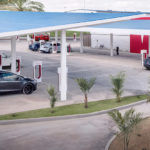
Tesla Superchargers are a network of 480-Volt, 145 kW capacity, fast-charging stations built by Tesla, Inc. exclusively for Tesla customers. The superchargers deliver DC power directly to the battery bypassing the car’s on-board chargers. Although the Superchargers are technically capable of 145 kW, Tesla cars restrict the power to 120 kW.
Supercharger stations typically have between six and twenty Superchargers. Use of the Supercharger network is either free or requires a small fee.
According to Tesla, each year, owners receive 400 kWh of free Supercharger credit, enough to drive about 1600 km. Customers who travel beyond the annual credit pay a small fee to Supercharge.
Tesla has been working on next generation V3 superchargers for more than a year now. The company is planning to unveil its next generation superchargers this year (2018).
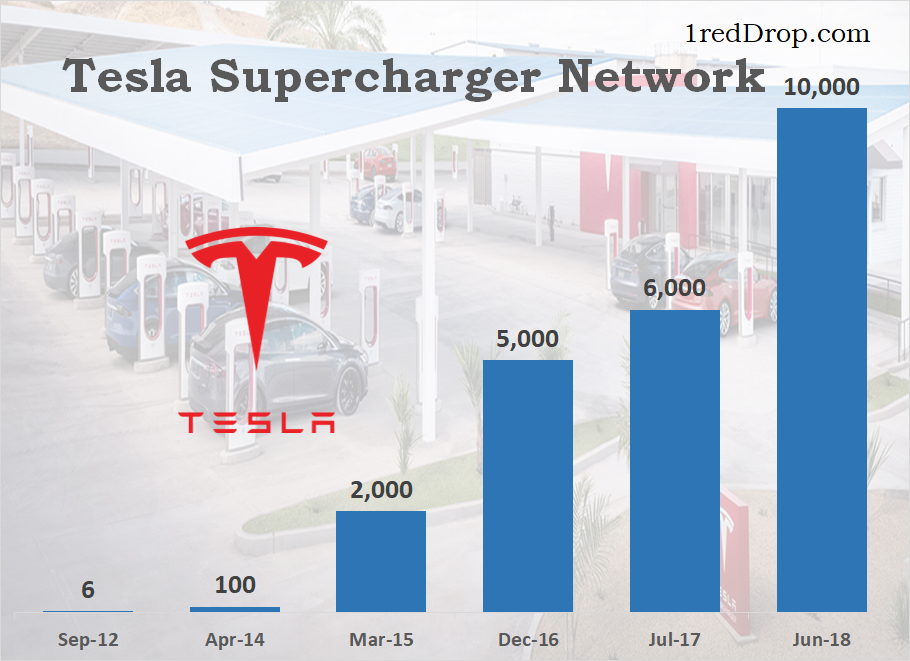
As of December 15, 2018 Tesla had 1,386 supercharger stations with 11,583 superchargers across the world.CEO Elon Musk announced that the company will double global supercharger capacity by the end of 2019.
Tesla unveiled its Supercharger network in September 24, 2012, (L) Six locations in California were unveiled during the event and two more were added in the East Coast by the end of 2012.
Supercharger Growth
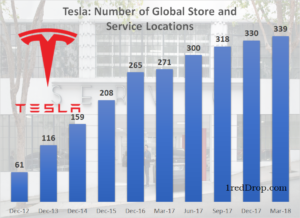
Unlike other automakers who operate a traditional franchised distribution network, Tesla own its sales and service network.
Tesla uses a mix of over-the-air updates, remote diagnostics, mobile service technicians and service centers to service and repair Tesla cars. Tesla recommends an annual service inspection every year or 20,000 km (EU) or 12,500 miles (non EU), whichever occurs first.
Tesla vehicles are designed with the capability to wirelessly upload the data to Tesla via an on-board system with cellular connectivity, allowing Tesla to do remote diagnosis. Tesla also says that its cars are designed so that most repairs can be done without raising the car on vehicle lift.
According to Tesla, 80% of repairs are minor and it can be done remotely saving customers the time travelling to and from a service center.
Tesla global store and service locations increased from 61 locations in December 2012 to 351 locations by September 2018. Number of mobile service vehicles increased from 160 to 373 between September 2017 and September 2018.
“Tesla says it has 47 robots deployed in scanning stations throughout the body line. They measure 1,900 points in every Model 3 to match them to design specs—with a precision of 0.15 millimeters. Torque measurements are also automatically recorded for every bolt that’s fastened. During the final test drives on the track, sound recorders measure squeaks, rattles and wind and road noise that a test driver might miss. All of this data is stored with each car’s unique Vehicle Identification Number, or VIN, so service centers can trace any issue back to a root cause in the factory. The idea is that Tesla will be able to improve its cars, even after they’re in a customer’s driveway. ” – Bloomberg
Tesla Employees
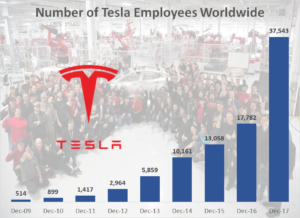
The number of employees working at Tesla increased from 514 to 37,543 between December 2009 and December 2017. The number of employees more than doubled in 2017 from 17,182 in 2016 to 37,543 in 2017 primarily due to Tesla’s acquisition of SolarCity.
At the end of 2015, SolarCity had 15,273 employees and it was reduced to 12,243 employees at the end of 2016.
CEO Elon Musk announced in June, 2018 that Tesla will cut 9% of its workforce as part of its reorganization. The job cut is expected to impact only salaried positions and not production associates. (L)
Tesla’s workforce is considerably smaller than large auto companies like GM, Ford, Toyota, BMW and Daimler.
Strength of workforce in 2017
-
Toyota: 364,445
-
Daimler: 289,321
-
Ford: 202,000
-
GM: 180,000
-
BMW: 129,932
Tesla : Worldwide Revenue
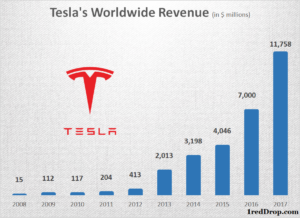
Tesla’s revenue grew from $14.74 million in fiscal year 2008 to 11.8 billion fiscal year 2017. Tesla is one of the fastest companies to reach $10 billion in annual revenues. Tesla has kept the pace with some of the fastest growing companies of our generation like Facebook and Amazon.
Tesla reported $14.74 million in annual revenue in fiscal 2008 and it took Tesla nine years to cross the ten billion dollars milestone in 2017. Facebook took eight years to increase revenue from $153 million in 2007 to $12.4 billion in 2014. Amazon took ten years to increase annual revenue from $15.74 million in 1996 to $10.71 billion in 2006.
Tesla is still a small company in terms of revenue when compared to large automakers like General Motors, Toyota, Ford, Daimler (Mercedes-Benz) and BMW.
Tesla’s competitor Mercedes-Benz reported annual revenue of €94.7 billion in 2017, while BMW reported €98.678 billion.
Tesla : Net Income (Net Loss)
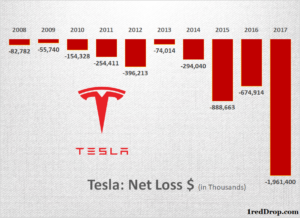
Tesla hasn’t turned annual profits since the time the company was founded in 2003.
Tesla reported net loss of $1.961 billion in fiscal 2017.Tesla reported only two profitable quarters since it went public in 2010. Cumulative net loss between 2008 and 2017 is $4.836 billion.
“Given that Tesla has never made an annual profit in the almost 15 years since we have existed, profit is obviously not what motivates us. What drives us is our mission to accelerate the world’s transition to sustainable, clean energy, but we will never achieve that mission unless we eventually demonstrate that we can be sustainably profitable. That is a valid and fair criticism of Tesla’s history to date” – Elon Musk in his email to Tesla Employees ( June 12, 2018)
Tesla: Research and Development Expense
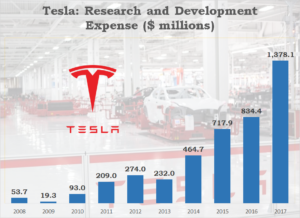
Tesla’s R&D spending reached $1.378 billion in 2017. R&D expenses increased $543.7 million, or 65%, in fiscal 2017 compared to the year before.
The increase was mainly due to $274.9 million increase in employee and labor related expense, and a $44.3 million increase in stock based compensation.
According to Tesla, “Research and development (“R&D”) expenses consist primarily of personnel costs for teams in engineering and research, manufacturing engineering and manufacturing test organizations, prototyping expense, contract and professional services and amortized equipment expense.”
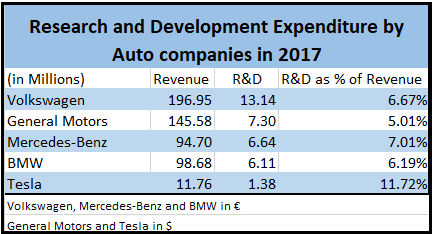
Tesla spent nearly 12% of its revenues in research and development in 2017, far higher than the mid single digit spending by large auto companies.
In comparison, General Motors spent $7.3 billion in R&D in 2017, Volkswagen spent €13.135 billion, while Mercedes-Benz and BMW devoted € 6.642 and € 6.108 billion towards research and development.
Tesla spent $4.276 billion in R&D from fiscal 2008 to fiscal 2017. Tesla’s operating loss during the period was $4.186 billion.
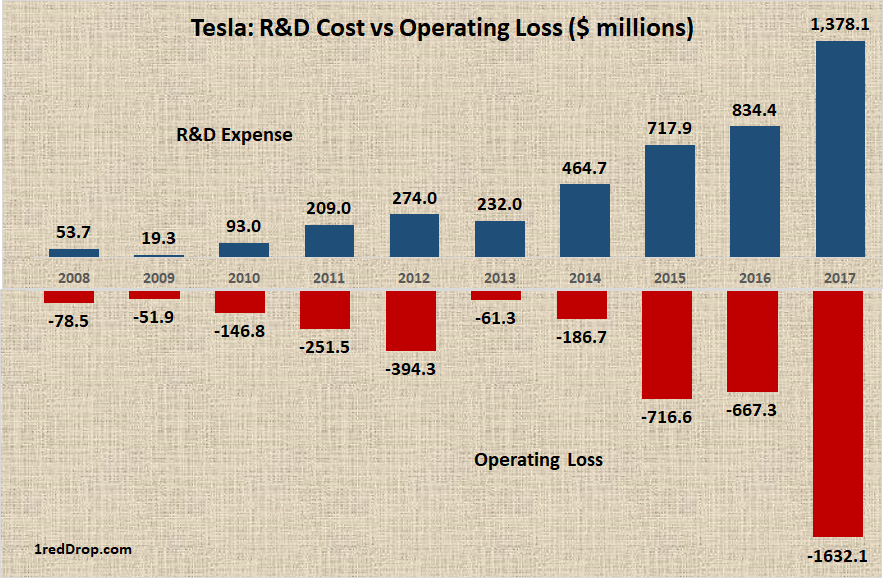
Tesla: Capital Expenditures

Tesla’s capital expenditures have grown exponentially since 2008. Tesla’s capex grew from just $10.6 million in 2008 to $3.41 billion in 2017.
Tesla’s capex spending in 2018 is expected to support increases in production capacity at Gigafactory 1, Tesla Factory, for building additional stores, services centers and for superchargers. Tesla now expects 2018 capex to be slightly lower than $3 billion.
Tesla has now spent $8.771 billion in capital expenditures from the first quarter of 2008 to the first quarter of 2018. A bulk of that spending happened over the last three years, as Tesla spent nearly $7 billion from 2015 to Q1-2018.
Tesla’s annual reports reveal that the company has made significant investment in Gigafactory 1. Tesla is building the Gigafactory 1, its battery plant, in partnership with Panasonic.
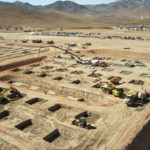
According to initial plans, Gigafactory 1 was estimated to cost $5 billion and Tesla’s contribution was expected to be about $2.0 billion over a five year period. But in its 2015 Annual report, Tesla warned investors that the cost of building and operating the Gigafactory could exceed current expectations due to its size and complexity.
Tesla has already spent $2.360 billion on Gigafactory 1 since it started construction in 2014. (2014 to Q1-2018)
Key Figures:
Total Capital Expenditure (2008 to Q1-2018): $ 8.771 billion
Total Five Year Capex (2013 to 2017): $7.564 billion
Gigafactory 1 (2014 to Q1-2018) : $2.360 billion
Tesla: Fundraising (Timeline)
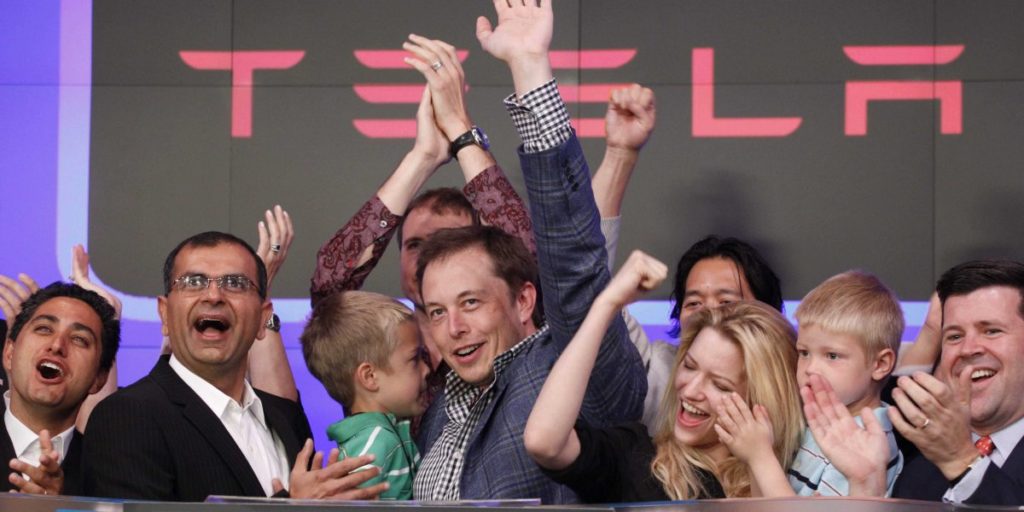 June 29, 2010: Tesla successfully launched its IPO on NASDAQ. Trading under the symbol TSLA, 13.30 million shares were offered to the public at $17. Shares closed at $23.89 on its first trading day. The IPO raised $226 million for Tesla.
June 29, 2010: Tesla successfully launched its IPO on NASDAQ. Trading under the symbol TSLA, 13.30 million shares were offered to the public at $17. Shares closed at $23.89 on its first trading day. The IPO raised $226 million for Tesla.
May 17, 2013: Tesla raised $913 million by offering $600 million convertible notes and a $313 million secondary stock offering. Tesla used the funds to repay all of its outstanding loans with the Department of Energy. (L)
February 2014: Tesla raised $2 billion by selling convertible debt
August 2015 : Tesla sold $738 million in stock (L)
May 2016: “Tesla Motors raised $1.46 billion in fresh capital from the sale of its 6.8 million new common stock offering.”
Tesla Acquisitions (Timeline)
Tesla bought privately held Perbix, an automated manufacturing equipment design company in November, 2017. (L)
Though the details of the deal were not announced by Tesla, CNBC reported that, ” In a filing, Tesla said it will pay stock and cash for Perbix and the company’s owner, Jim Dudley, would receive 34,772 shares in Tesla, worth about $10.5 million at the company’s current share price of around $300.
Tesla completed its $2.6 billion acquisition of SolarCity, a solar energy company founded by his cousins Lyndon and Peter Rive, on November 2016.
The acquisition made SolarCity, the nation’s largest manufacturer and installer of solar panels at that time, a wholly owned subsidiary of Tesla.
Tesla acquired Germany based Grohmann Engineering in November 2016 for approximately $135 million. (L)
At the time of acquisition, “Tesla CTO JB Straubel explained that Tesla has been working with Grohmann in a partnership for the past few months, and found that the teams complemented each other well and were achieving a lot in terms of automation improvements, and determined they could do even more as a combined company.” – Techcrunch
Tesla acquired Grand-Rapids based Tool and Die company Riviera Tool in May, 2015, the first acquisition in the company’s history. (L)
Riviera, which made stamping parts for Tesla’s assembly plant in Fremont, Calif., had nearly 100 employees at the time of acquisition.
“The official price of the acquisition was not reported, but MiBiz listed the deal as a finalist in the 2015 MiBiz M&A Deals and Dealmakers of the Year Awards in the less than $25 million category.” – Teslarati
Tesla Depreciation
Electric Vehicles and Hybrids depreciate faster than their gasoline counterparts.(L)
A report by NADA shows that in 2015(US), gasoline-powered models depreciated by an average of roughly 15% to 16% while hybrid model prices fell by 17% – 18%. By comparison, prices of used plug-in hybrids fell by an average of 25%, while most EV models experienced losses exceeding 30%.
Similar to any used product, some cars retain value longer than others. Tesla cars tend to hold their value at a much better rate when compared to cars in its class.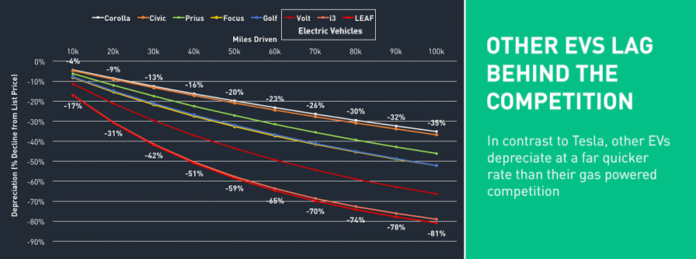
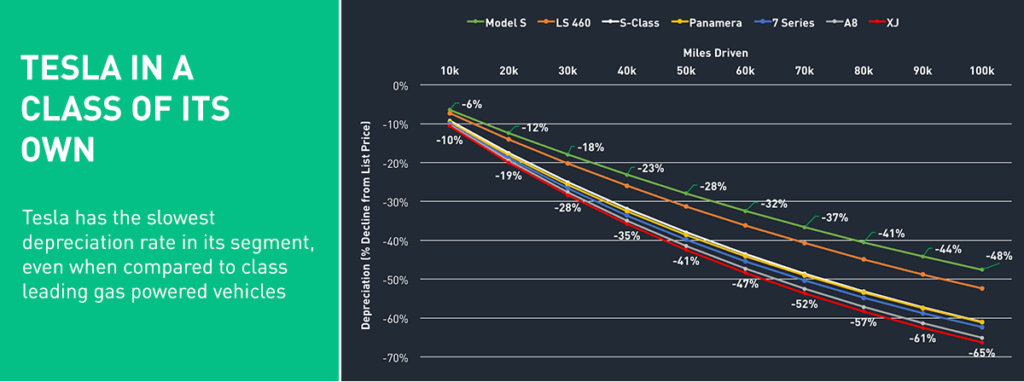
In 2016, Alex Klein, Autolist’s Vice President of Data Science, wrote in an email to Electrek, “To put the depreciation in context, whereas a Tesla (Model S) will on average lose 28% of its value after being driven 50k miles, a Mercedes S-Class will lose 38%, a BMW 7-series will lose 40%, and an Audi A8 will lose 41%. As a result, Tesla owners end up with considerably more money in their pocket.”
Tesla Insurance
Tesla partnered with Liberty Mutual Insurance to launch InsureMyTesla in October, 2017, a car insurance product for Tesla vehicles in United States.
At the time of launch in United States, InsureMyTesla program was already available in 20 countries around the world. Tesla partnered with AXA General Insurance in Hong Kong and QBE Insurance in Australia. (L)
According to a list created by 24/7 WallStreet using data from Insurance Institute for Highway Safety, Tesla Model S 4WD is the most expensive car to insure in the United States with an annual average insurance of $1.789.48. Mercedes-Benz Model S took the second place with an annual average insurance of $1,540.63.
Tesla’s InsureMyTesla launch in United States closely followed the announcement by AAA in June, 2017 that premiums for Tesla vehicles could go up by 30% due to high claim frequency and high cost of insurance claims.
Tesla disputed the claim. “This analysis is severely flawed and is not reflective of reality,” Tesla said in a statement emailed to Automotive News. The automaker said the Highway Loss Data Institute compared its cars to the wrong competitors, including a “Volvo station wagon.” In a more direct comparison, Model S and Model X claim data would not stand out negatively, Tesla said.
According to Tesla, InsureMyTesla offers the following benefits:
• New Car Replacement – Allows for a brand new car within the first year in case of a total loss
• Rate guaranteed for one year
• Genuine Replacement Parts
• Optional 24-Hour Roadside Assistance beyond the Tesla Warranty
• Optional Rental Car Reimbursement to pay your rental costs for as long as it takes to fix your Tesla
• Claims Valet Service to drop off a rental car at the scene or schedule a swap at an agreed upon time and place
More details and disclaimer can be found in InsureMyTesla PDF Brochure
Tesla Recalls
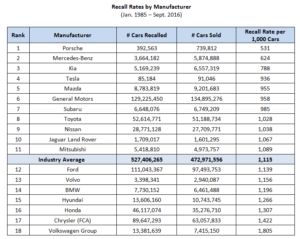
A 2016 study by iSeeCars.com analyzed over 31 years of recall history and found that Porsche boasts the lowest “recall rate” and Volkswagen the highest, GM has the best “recall timeliness” of the major automakers, and Tesla earns the best “recall proactiveness” and Ford the worst.
According to National Highway Transportation Safety Administration data analyzed by iseecars, Tesla recalled 941 cars per 1000 manufactured (2012-2016). Tesla did better than the industry average, but still lagged Porsche (531/1000) and Mercedes-Benz(624/1000).
The industry average recall rate is 1115/1000 cars because most cars are recalled more than once in their lifetime.
Cause: Excessive corrosion in the power steering bolts, in very cold climates, particularly those that frequently use calcium or magnesium road salts, rather than sodium chloride (table salt).
Affected Cars: Model S sedans made before April 2016
Cause: Faulty locking mechanism in Model X second-row seats that increases the risk of the seats falling forward in a crash.
Affected Cars: Model X manufactured between October 28, 2016 and August 16, 2017. (L)
Cause: According to Tesla, Electric parking brakes installed on Model S and Model X “may contain a small gear that could have been manufactured improperly by our third-party supplier”. (via BBC)
Affected Cars: Model S and Model X built from February 2016 to October 2016
Cause: Faulty locking hinge in the third-row seats increases the risk of seats falling forward in a crash.
Affected Cars: Model X SUVs built before March 26, 2016. (L)
Cause: Front seat belt that was not properly connected to the outboard lap pretensioner. (L)
Affected Cars: All Model S cars built by Tesla from June 2012 to November 2015
Cause: Adapters used for recharging Model S may overheat.
“The recall says that the NEMA 14-50 adapters used to charge Model S vehicles could exhibit higher than normal resistance when subject to corrosion, damage or fluctuating outputs of electrical sockets.” (L)
Cause: Defect in the mounting bracket of the rear seat.
Affected Cars: Model S manufactured between May 10, 2013 and June 8, 2013. (L)
Tesla: Customer Deposits
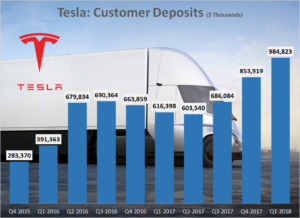
Customer deposits (reservations) and advance payment for limited edition vehicles have played a huge role in helping Tesla’s financial position by bringing in addition cash flow.
Tesla unveiled 1st generation Roadster on July 19, 2006. The first 100 signature Roadsters were sold out within three weeks of launch and by December, 2006 Tesla had 250 customers paying $100,000 to reserve their Roadster. Reservations swelled to 400 by May 2007.
Tesla unveiled Model S sedan in March 26, 2009.
By May 2009, Tesla Model S had crossed 1000 reservations and by December 2012, net reservations increased to 15,000. Reservation fee for Model S was $5,000
Tesla launched Model 3 on March 31, 2017 and started accepting reservations online as well as stores on the same day. Model 3 reservation costs $1000.
Two days after Tesla started accepting reservations, orders reached 232,000 and by July, 2017 Tesla had 455,000 net reservations. According to Tesla’s first quarter 2018 share holder letter, net reservations for Model 3 is over 450,000.
Tesla unveiled Semi, its all electric truck in March, 2017. Tesla also unveiled Roadster 2020 during the same event. The founders series Semi and Roadster requires customers to pay $200,000 and $250,000 respectively, while base reservation for the semi costs $20,000 and $50,000 Roadster.
Customer deposits increased from $283 million in Q1-2015 to $984 million in Q1-2018.
Tesla Board Of Directors
Elon Musk— Product Architect and CEO of Tesla
Brad W. Buss—Former CFO of SolarCity Corporation
Robyn Denholm—Chief Operations Officer of Telstra Corporation
Ira Ehrenpreis—General Partner, Technology Partners
Antonio J. Gracias—CEO of Valor Equity Partners
Steve Jurvetson—Managing Director, Draper Fisher Jurvetson.
James Murdoch—CEO of 21st Century Fox
Kimbal Musk—Co-Founder of The Kitchen
Linda Johnson Rice— Chairman and Chief Executive Officer of Johnson Publishing Company (JPC)
Tesla Models
Model S – The Sedan
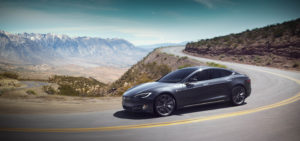 The Tesla Model S is a large luxury all-electric sedan manufactured by Tesla, inc. Model S was designed by Tesla’s Chief Designer, Franz von Holzhausen, who previously worked with Mazda.
The Tesla Model S is a large luxury all-electric sedan manufactured by Tesla, inc. Model S was designed by Tesla’s Chief Designer, Franz von Holzhausen, who previously worked with Mazda.
The Launch
Tesla unveiled Model S sedan in March 26, 2009, but it took Tesla nearly three more years to start customer delivery, which began on June 22, 2012
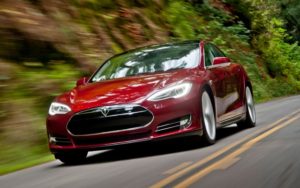
Early Demand
Immediately after the launch, Tesla started accepting Model S reservations for a $5000 fee. Tesla had 520 reservations within a week after the launch and by May 2009, Tesla had already crossed 1,000 reservations.
By December 2012, Tesla had a total of 15,000 net reservations.
The 1000 Special edition Model S Signature Series with listed price of $87,900 were sold out before Tesla started deliveries in June 22,2012. Performance versions were priced at $92,850 and $97,900. L
Where is it built?
Tesla currently builds Model S in the United States and exports its worldwide. For Europe, Tesla ships its cars as knocked down units and re-assembles the parts in its factory in Tilburg, Netherlands
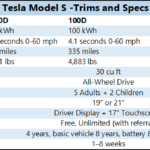
Configurations
Model has three base configurations:
75D Dual Motor All Wheel Drive – EPA range of upto 259 miles, 75 kWh battery with top speed of 140mph
100 Dual Motor All Wheel Drive – EPA range of 335 miles, 100kWh battery with top speed of 155mph
P100D Performance Dual Motor All Wheel Drive– EPA range of 315 miles, 100 kWh battery with a top speed of 155 mph
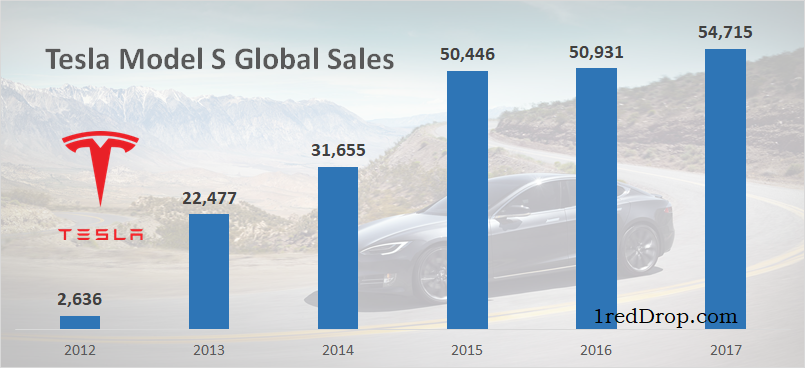
Sales Records
Tesla Model S was the world’s second best selling electric car in 2017, with the number one occupied by BAIC EC-Series (China). L
In the United States, Model S was the best selling electric car for two years in a row, 2017 and 2016. L
Tesla has delivered 224,590 Model S worldwide since the time it started delivery in June, 2012 up to March, 2018. This makes Tesla Model S is the second most sold electric car in the world after Nissan Leaf (300K) L
Tesla Model S Global Roll-out (Major Markets)
Safety Rating
-
2016 Tesla Model S 60 scored the highest possible safety rating of 5.0, from NHTSA ( National Highway Traffic Safety Administration). L
-
2014 Tesla Model S 85kWh received a 5-star Euro NCAP rating. L
-
2017 Tesla Model S failed to get a Top Safety Pick rating from the Insurance Institute for Highway Safety (IIHS) and was accorded an “Acceptable” rating by the agency. L
“Tesla’s Model S received the highest rating in IIHS’s crash testing in every category except one, the small overlap front crash test, where it received the second highest rating available”, a Tesla spokesperson said in an email to Reuters.
Top Awards
Time Magazine – Best 25 Inventions of the Year 2012 award
Tesla Model S is Consumer Reports’ top-rated ultra-luxury sedan. L
Model X
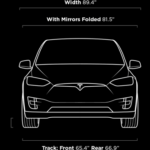
Tesla Model X is a all-electric, mid-size, luxury, sports-utility-vehicle made by Tesla, inc. Model X was unveiled on February 9, 2012. Customer deliveries for the Model X began with Signature series on September 29, 2015. Deliveries were rescheduled from early 2014 to late 2014 and then to third quarter of 2015.
According to Tesla, “Model X is the safest SUV ever. Built from the ground up as an electric vehicle, the body, chassis, restraints and battery technology provide the lowest probability of occupant injury.”
Model X has the highest possible five star rating from National Highway Transportation Safety Administration (NHSTA).
Sales
Model X sales totaled 206 units during the last quarter of 2015, increasing to 9,500 in the fourth quarter of 2016. Global deliveries totaled 212 units in 2015, 25,312 units in 2016, 46,535 in 2017 and 10,070 in the first quarter of 2018.
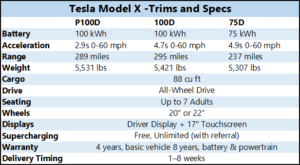
The United States remains the major market for Model X with an estimated 21,315 units sold in 2017. Cumulative global sales since Tesla started delivering Model X in September 2015 reached 82,129 units by March, 2018.

